About Us
Home / About Us
ABOUT US
Kyokushinkai India is a Government registered trust operating nationally. It is founded by Hanshi Shivaji Ganguly, the DISCIPLE and BRANCH CHIEF of Sosai Mas Oyama and it is currently affiliated World SO-KYOKUSHINKAI (Shizouka, Japan) whose president is Hanshi Daigo Ohishi. This organisation is operating from 1980s.
The headquarters of Kyokushinkai India is at Kolkata and it operates democratically with a proper committee which is headed by Hanshi Shivaji Ganguly, the honorary life time president of this organization.
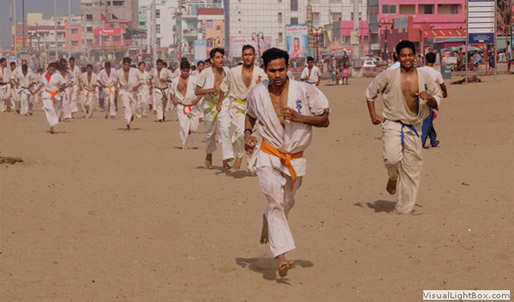



The primary objective of KyokushinKai India is to propagate, practice and preserve Kyokushin Karate. It truly cultures and works for the development of the original KYOKUSHIN KARATE which was created by Sosai Masutatsu Oyama. Hanshi Shivaji Ganguly, being MAS OYAMA’s direct and one of the best students from Asia, is carrying on the legacy of Mas OYAMA’s BUDO FULL CONTACT KARATE in its true spirit.
In India Kyokushinkai India ( which was then called ) was the only Kyokushin Organisation to invite and host SOSAI MAS OYAMA in the year 1991 who came here as the chief guest of “OYAMA CUP” one of the famous national level Kyokushin tournament of that time .
KyokushinKai India organizes different tournaments (international, national, state etc.), Camps, seminars and workshops etc. every year and has become a well renowned FULL CONTACT KARATE organization. Following the footsteps of its world body, Kyokushin India is holding high the beam of Full Contact Karate and has started Olympic movements dedicatedly.
Kyokushin has influenced many of the “full-contact” schools of karate, emphasizing realistic combat, physical toughness, and practicality in its training curriculum. Many other martial arts organizations have “spun-off” from Kyokushin over the years, with some additional techniques, such as grappling. But KyokushinKai India is the only organization which propagates authentic Full Contact Karate and maintains its philosophy truly.
HISTORY
THE CHRONICLES OF KYOKUSHIN KARATE IN INDIA
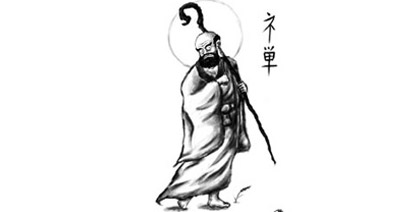
Martial arts are codified systems and traditions of combat practices, which are practiced for a variety of reasons: self-defense, competition, physical health and fitness, entertainment, as well as mental, physical, and spiritual development.Although the term martial art has become associated with the fighting arts of eastern Asia, it originally referred to the combat systems of Europe as early as the 1550s. The term is derived from Latin, and means “arts of Mars”, the Roman god of war.
In 1429, the three kingdoms on Okinawa unified to form the Kingdom of Ryūkyū. When King Shō Shin came into power in 1477, he banned the practice of martial arts. Tō-te and Ryukyu kobudō (weaponry) continued to be taught in secret. The ban was continued in 1609 after Okinawa was invaded by the Satsuma Domain of Japan. The bans contributed to the development of kobudō which uses common household and farming implements as weaponry. The Okinawans combined Chinese martial arts with the existing local variants to form Tōdeand formed Okinawa-te.
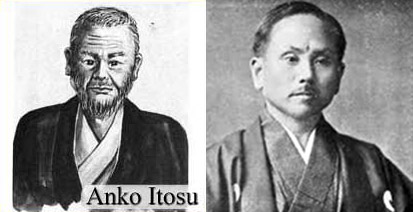
Ankoitosu and Ankoasato were the two exponents of the Okinawan shuri –te and are considered to be the “fathers of modern karate “. Gichin Funakoshi learnt the art from them and it is believed he brought it to Japan. After that Shotokan Karate was born and different other styles initiated. (which are now the part of World Karate Federation and follows non-contact karate rules)
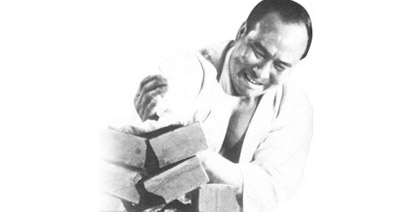
He with an urge to find the ultimate truth went into solitude and trained in mountains intensely. He used to inspire himself by reading “The Book of Five Rings “by Miyamoto Musashi, a famous Japanese swordsman. After years training he gave birth to strongest full Contact Karate – KYOKUSHIN KARATE , which has
His power, skills and techniques conquered all and “KYOKUSHIN” soon became a name internationally.Finally in 1964 he formed the “International Karate OrganisationKyokushinKaiKan “. SosaiOyama passed away in the year 1994 leaving behind a huge organization, which had its branches in about 120 countries and had 10 million members. The organization gradually broke down into groups each claiming their authority over original Honbu. The organization broke into two prominent groups one led by Mr. Matsui and the other one started running democratically. With time to resolve legal dispute the second group was renamed in 1996 as NPO KyoKUSHINKAI which is referred to as WKO (World Karate Organisation) also and the president was Hanshi Nishida.
In India Kyokushin karate entered in the year 1977. Hanshi Shivaji Ganguly,then 21 started practicing Kyokushin Karate. In 1982 Hanshi Ganguly completed his shodan and won the 1st runners up trophy in Asian Championship in Singapore which highlighted India in the map of Kyokushin karate. Soon after that corruption started invading Kyokushin in India. He being a man of principles stood against the corruption and started newly. He received huge support from all the contemporary students .
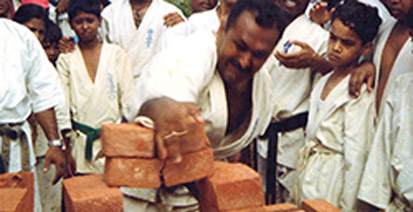
Soon after that he got an opportunity to train under the founder of Kyokushin Karate himself. His dedication made him one of the favourite students of Sosai Mas Oyama. Many tried along with him but could not withstand the intensity of the uchideshi training which he went through. He completed Nidan by doing 20 men kumite under the supervision of Sosai himself. He was the only Indian who was allowed by Sosai to appear for third dan within 10 months. He lived upto his guru ‘s expectation and impeccably completed 30 men kumite ( one minute each ) atHonbu (World H.Q. , Japan) and received the belt from Sosai’s hand . Being a native of a third world country this was really difficult for him both economically and physically. But seeing his iron determination Sosai gave him the charge as a branch chief.
It is because of him that Sosai came to India in 1991 as a chief guest of the National tournament which was started by Hanshi Ganguly in the name of Sosai Mas Oyama – “Oyama Cup”.
Seeing his wonderful advancements in 1991 Sosai awarded him with 5th Dan in the branch chief camp at Ugawara , Japan. He started his work vigorously and with full determination he dedicated himself for the propagation of the art nationally. He selflessly started teaching the art to the young generation. At that time he became the only icon of Karate in West Bengal and in India. The youth started following him then.
During that time without thinking of getting benefitted economically he even taught many poor and underprivileged students free of cost. Mr. Ganguly became more popular in the karate world of India. His performance and strength started inspiring people and the other karatekas from other organisations got attracted towards Mas Oyama’sBudo Karate. He used to follow Mas Oyama’s principles of BUDO spirit blindly and has never compromised with indiscipline. Hanshi Ganguly formed the organization like his family with intense love and care , spending not only years , months and days , but also every minute and second behind the development of his students and tried to inculcate the true Budospirit in them .
After Sosai’s death when the mother organization got divided he chose KyokushinKai from its inception and stood firmly with the organization whereas his contemporaries chose the organization led by Mr. Matsui. He was named as Asian Chairman in 1996 and from then onwards he founded KyokushinKai India under the leadership of WKO and dedicatedly started working for the development of the organization. However, the organisation joined in collaboration with IKO World So-Kyokushin on October 2016 due to unavoidable circumstances. He served the organization as the Asian Representative for 16 years and then he resigned and became the country representative of India. He is still carrying on with full dedication at the age of 67. The Indian organization is a government-registered body and is running democratically with Hanshi Ganguly working as a president.